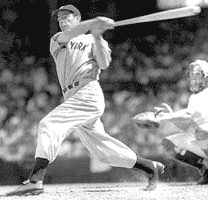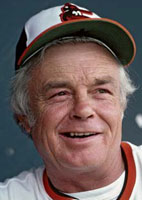CONTENTS
Historic Day at the Polo Grounds
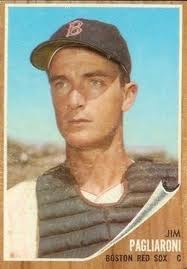 |
On June 18, 1961, the Washington Senators score five runs in the top of the ninth to take a commanding 12-5 lead in the first game of a doubleheader at Fenway Park. In the bottom of the inning, starter Carl Mathias retires 1B Vic Wertz on a groundout. Then things get dicey.
The Red Sox score 8 runs with two out to win 13-12.
|
 |
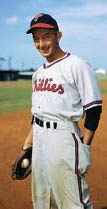 Eddie Waitkus
|
In 1949, 29-year-old Eddie Waitkus got off to the best start of his baseball career. After 54 games, the left-handed hitter was batting .306 for the Philadelphia Phillies and leading the All Star balloting for 1B. On June 14, the Phillies were in Chicago to start a series with the Cubs, the team that had originally signed Waitkus in 1939. After serving in World War II, Eddie played three full seasons for the Cubs before being traded to Philadelphia in December, 1948.
Unknown to Waitkus, he had caught the eye of a Chicago girl named Ruth Ann Steinhagen. At age 16, she started attending games at Wrigley Field and became obsessed with the home team's first sacker. She collected hundreds of pictures and newspaper clippings and built a shrine to him in her bedroom. Ruth's parents sent her to a psychiatrist to no avail. When Eddie was traded, the 18-year-old girl cried and said she didn't want to live. When the Phillies came to the Windy City the following June, Ruth decided it was time to meet Eddie. Following the Phillies' 9-2 victory over the Cubs on June 14, Waitkus joined his roomate Russ Meyer and others for supper. When Meyer returned to their room in the Edgewater Beach Hotel about 11:45 pm, he found a note addressed to Waitkus from "Ruth Ann Burns" telling him she wanted to see him in room 1297. When Eddie came in a few minutes later, Meyer gave him the note. Ironically, Eddie had dated a woman named Ruth Ann and assumed the note was from her. So he went to the room. When Ruth Ann Steinhagen answered the door, she told him that the note's writer had stepped out for a moment and invited him in. After Waitkus sat down, Steinhagen went to the closet, pulled out a 22 caliber rifle, and shot him in the chest, stating that if she couldn't have him, no one could. Then she called the front desk, told them what she had done, and left. Without that call, Eddie would undoubtedly have bled to death. Based on Waitkus's identification from his hospital bed, Steinhagen was charged with the shooting on June 30. She said she "wasn't sure" why she had shot Waitkus, adding "I'm not really sorry. I'm sorry that Eddie had to suffer so, but I had to relieve the tension I have been under the past two weeks." A jury found her legally insane, and she was committed to a mental institution. After receiving shock treatments, she was released in April 1952, less than three years after the shooting. Waitkus underwent four operations before heading to Clearwater FL for rehab. Amazingly, he returned for the 1950 season, hitting .284 and scoring 102 runs to help the Phillies win their first pennant since 1915. Eddie played with Philadelphia through 1953, then joined Baltimore for a year and a half before finishing his career with the Phillies in the latter part of 1955. Psychologically, Eddie went from being sociable and easygoing to reclusive and mistrusting after the shooting. Following his retirement, he was treated for alcoholism. He died in 1972 at age 53. |
Here are some interesting situations created by the rules of the game – or ignorance of those rules.
- On July 11, 1919, Bill Rariden, C for the Cincinnati Reds, hit a strange HR in the first inning of a game at Braves Field in Boston. The scoreboard boy had neglected to close one of the inning openings where a number would be placed later. Rariden's hit rolled through that opening. According to the rules in force at the time, the batter could continue to run until the ball was retrieved or he reached home plate. If the same situation happened today, the batter would be awarded only a ground rule double.

Braves Field, Boston
- In a 1934 game between the Boston Braves and the Brooklyn Dodgers, a Braves batter singled. When Dodger C Ray Berres received the ball, he tossed it to 1B Johnny McCarthy. "Throw it out, John. It's wet." McCarthy obliged, tossing the ball into the dugout. The only problem was that Berres had forgotten to ask for time. So the umpires advanced the runner two bases because the live ball went into the dugout.
- When Eddie Stanky managed the White Sox (1966-8), he taught his 3B, Pete Ward, to pull a neat trick. When an opponent attempted to score from second on a hit, Ward would move into the path of the runner, then step aside just before the runner reached him. Even though there was no contact, the runner would break stride just enough to give the Chicago OFs a chance to nail him at home. The umps finally caught on to Ward's ploy and called him for obstruction several times until Stanky pulled the plug on the caper.
Reference: The Rules and Lore of Baseball, Rich Marazzi
|
 John Lowenstein |
Earl Weaver of the Baltimore Orioles was one of the first managers to rely heavily on statistics when making decisions during games. From 1977-82, the team statistician, Charles Steinberg, prepared index cards for Earl to refer to during contests. A particularly effective use of Steinberg's work occurred during the first game of the 1979 ALCS against the Angels. John Montague was warming up in the bullpen in the bottom of the tenth with the scored tied 3-3. Since the right-handed reliever had been acquired from Seattle late in the season, Earl didn't have a card for him. So he called Steinberg in the press box and asked him to look up Montague's stats. Weaver sent his daughter, a stadium attendant, to get the card from Steinberg. She hurried downstairs through the Orioles' clubhouse past a naked Jim Palmer (she shielded her eyes) to give the card to her father. Seeing that John Lowenstein owned Montague, Earl sent Lowenstein to pinch hit. John responded with a 3-run walk-off homer. Steinberg was not your usual statistician. He began working for the Orioles in high school. He earned his doctorate from the University of Maryland dental school in 1984 and served as the Orioles' dentist while continuing to work in the front office. A Renaissance man, he created the club's first video production department and first customer service department. Steinberg won an Emmy Award for his television production of the story of the 1998 NL champion Padres, and a Telly Award for his video on the 1989 Orioles. He also appeared in "Fever Pitch," a fictional movie that featured the 2004 Red Sox winning their first World Series title in 86 years. In November 2007, the Los Angeles Dodgers hired Steinberg as their chief marketing officer, undoubtedly making him the first dentist to ever hold that position for a major league team.
|
Reference: "Between the Lines," Steve Wulf, ESPN the Magazine |
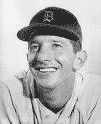 Billy Martin  Joe Morgan |
 Fred Merkle |
The 12,000 fans who attended the Saturday, May 13, 1911 game between the New York Giants and the visiting St. Louis Cardinals at the Polo Grounds saw their hometown heroes set two records that stand to this day.
Reference: Baseball Bits, Dan Schlossberg |
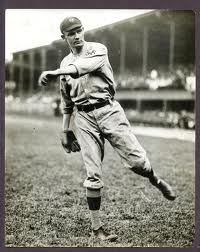 Rube Marquard |
 |
Casey Stengel was famous for butchering the English language. One of his meandering soliloquies occurred during spring training of 1962, the first year of the expansion New York Mets, when Casey was asked about his lineup. After he revealed the names of some of his starters, he continued:
It obviously took Casey awhile to remember the name of Gus Bell, who had just finished nine solid years with the Cincinnati Reds. And his "big family" included son Buddy, who played in the majors from 1972-1989, mostly at 3B, and has managed three different clubs. Also Buddy's son David played IF with several teams from 1995-2006, and another son, Mike, played briefly with Cincinnati in 2000.
|
 Gus Bell |

